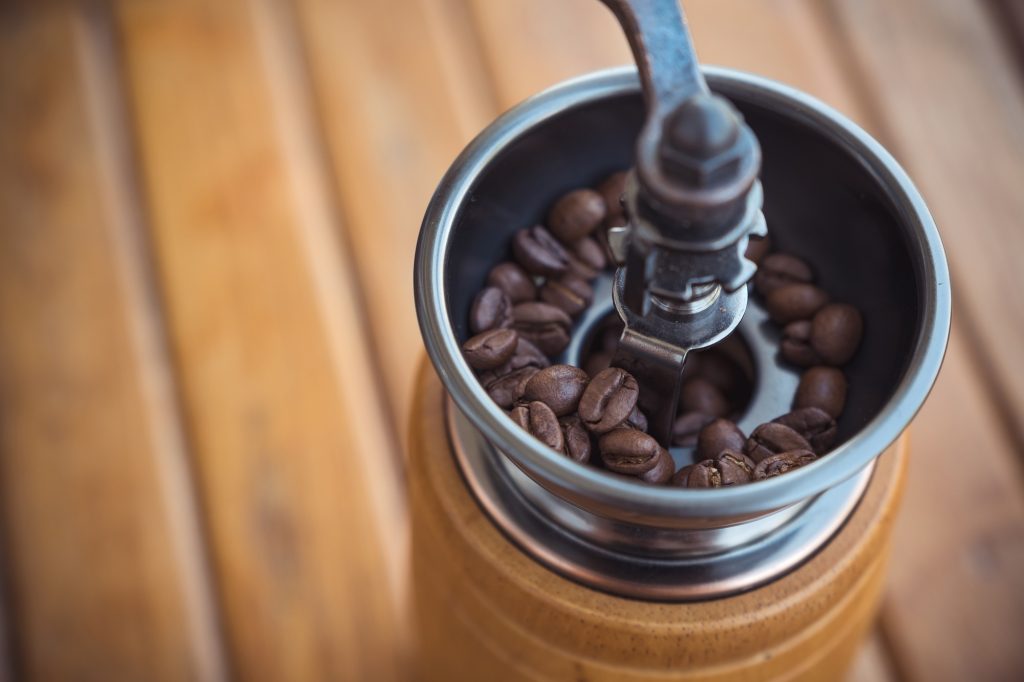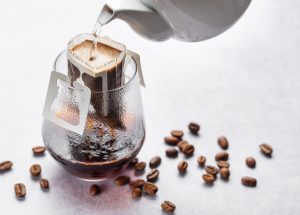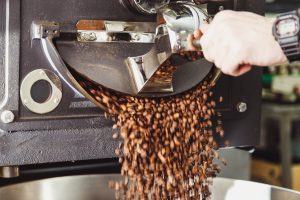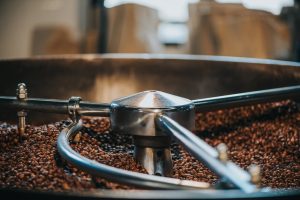
Looking for an alternative to a coffee grinder? We’ve got you covered. Discover how to grind coffee beans with common kitchen tools, ensuring freshly ground coffee every time. Whether you’re using blenders and food processors for effective grinding with pulse settings and short bursts to avoid overheating or opting for manual methods like rolling pins and mortars for precision and control over grind size, there’s a solution for every coffee lover. Achieving a consistent grind size is essential for optimal coffee flavor and extraction, so experiment with various methods to find your perfect brew. With these easy and effective techniques, you
Grinding Coffee Beans with a Blender

When life gives you whole-bean coffee and no grinder, reach for your blender! Believe it or not, a blender can be a surprisingly effective tool to grind coffee beans. Begin brewing process by selecting the ‘grind’ or ‘pulse’ settings on your blender, which are designed for tougher items and will help achieve a consistent grind.
For optimal results, use short bursts. Continuous grinding generates heat, which can lead to bitter beans. Pulse the blender in very short pulses at intervals of about 3-5 seconds to prevent overheating and preserve the coffee’s flavor.
Occasionally, shake the blender to redistribute the beans for an even grind. Though the blending process is not perfect, it can save your morning coffee drinker ritual in a pinch. Just remember to clean your blender thoroughly afterward to avoid any lingering coffee aromas in your next smoothie.
Using a Food Processor for Grinding Coffee Beans

Next up on our list of coffee grinder alternatives is the food processor. A food processor is a versatile kitchen appliance that can effectively grind coffee beans without using, similar to a blender but with a few key differences.
Add more beans than you would with a blender to achieve a more even blend and consistency when using a food processor. Pulse the processor for 3-5 seconds at a time and shake occasionally to ensure even grinding and avoid overheating, which can affect the flavor.
Store any excess ground coffee in a sealed container to maintain its freshness once you’ve achieved your desired consistency of grind. This method is particularly useful if you’re making a larger batch of coffee grounds for the week. A food processor can help maintain your coffee ritual for both drip coffee and cold brew, even without a traditional grinder.
Crushing Coffee Beans with a Rolling Pin
Using a rolling pin to crush coffee beans is an excellent option for those who enjoy a bit of manual labor. This method is particularly useful for achieving a coarse grind, perfect for French press coffee.
Place your coffee beans in a Ziplock bag to contain the mess. Use the rolling pin like a hammer to crush the beans initially. This first step breaks the beans into smaller, manageable pieces, making it easier to roll over them later. Once sufficiently crushed, roll the beans with consistent pressure for a more uniform grind.
This method not only gives the coffee machine control over the grind size but also requires no electricity, making it ideal for those who enjoy camping or find themselves without power. While it’s a bit of a workout, the results are worth the effort. There’s something satisfying about using simple tools to create fresh coffee.
Mortar and Pestle Method for Coffee Beans

The mortar and pestle method is as old-school as it gets, and it’s a fantastic way to grind coffee beans without a grinder. This traditional method allows for precise control over the grind size, making it a great choice for those who are a bit particular about their coffee.
Grind about a quarter cup of coffee beans at a time with a mortar and pestle to better control the grind. Press and roll the pestle on the beans, adjusting pressure and grinding time to achieve roughly the same size and desired consistency. This method produces a fine grind, ideal for making drip coffee or Chemex.
Though it takes more elbow grease than other methods to bean coffee, using a mortar and pestle is rewarding. The tactile process uniquely connects you to your coffee, resulting in a finely ground coffee ready to brew.
Hammering Coffee Beans for a Coarse Grind
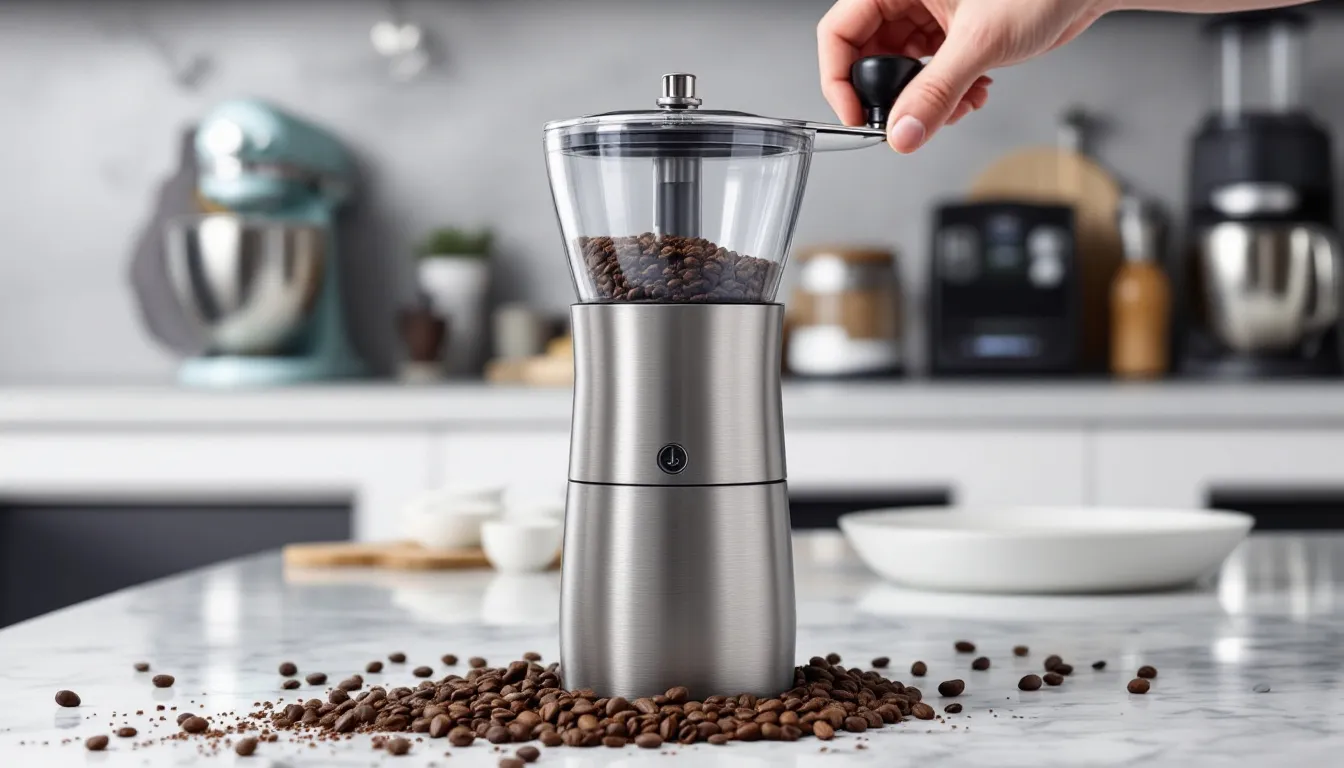
Hammering your coffee beans might be the way to go if you prefer a straightforward method that doesn’t require special tools. This technique is ideal for the beans achieving a coarse grind, perfect for cold brew.
Place your coffee beans in a plastic bag on a sturdy surface, such as a cutting board. Crush the beans with a hammer, applying consistent pressure to grind beans for a uniform grind. Using a strong, sturdy surface minimizes mess and ensures even grinding.
Hammering coffee beans is a simple yet effective method that requires minimal effort and no electricity. This technique can help achieve a coarse grind perfect for your favorite brewing methods, whether at home or outdoors.
Traditional Stone Grinder (Sil Batta) for Coffee Beans

The Sil Batta, a traditional stone grinder, offers a unique and effective way to grind coffee beans without a grinder. Consisting of a flat stone and a grinding stone, this method has been used for centuries to grind various ingredients, including coffee.
A Sil Batta preserves the natural taste and flavor of the whole beans while also providing a physical workout. Place the coffee beans on the surface area of the flat stone and use the grinding stone to crush and grind them. Though it requires some effort, the result is a consistent grind that enhances the coffee’s flavor.
Though not the most convenient method, the Sil Batta offers a traditional and tactile way to grind coffee beans. It connects you to the ancient practices of coffee preparation, adding an extra layer of appreciation to your morning brew.
Why Consistent Grind Size Matters
A consistent grind size is crucial for brewing the perfect cup of coffee, directly impacting extraction speed and flavor. Coarse grounds allow water to flow quickly, while finer grounds require boiling water for a faster brewing method.
The ideal grind size depends on your brewing method. A small cup of medium-coarse grind is often recommended for optimal extraction, while French press coffee requires coarser grounds, and espresso needs a fine grind. Inconsistent grind size can cause under-extraction, resulting in weak coffee or over-extraction, leading to bitterness.
Achieve a consistent grind size by grinding coffee beans in small batches and using methods that offer precise control, such as the Sil Batta. This ensures that each cup of coffee you brew is flavorful and balanced.
Tips for Perfectly Ground Coffee Beans
Achieving the perfect grind for your coffee beans can be an art. Experiment with different grinding beans techniques to find the grind that best suits your taste. Each method—blender, food processor, rolling pin, or mortar and pestle—offers a unique grind that can affect the coffee’s flavor and strength.
Consider using a manual or burr grinder for a more consistent grind. These tools are specifically designed for coffee beans and offer more control over the grind size. A coarse grind is ideal for French press coffee, while a finer grind suits drip coffee and espresso better.
Ultimately, experiment to find what works best for you. Each brewing method and personal preference will require a different grind, so don’t hesitate to try new techniques and adjust as needed. Happy grinding!
Explore Creative Coffee Grinding Methods
There are numerous ways to grind coffee beans without a traditional coffee grinder. Whether you choose to use a blender, food processor, rolling pin, mortar and pestle, hammer, or even a traditional stone grinder, each method has its unique advantages and can produce a grind suitable for various brewing methods.
The key takeaway is to experiment with these alternatives and find the one that suits your needs and preferences. Consistent grind size is essential for a balanced and flavorful cup of coffee, so take the time to perfect your technique. With a bit of creativity and effort, you can enjoy freshly ground coffee anytime, anywhere.
For more tips and insights on coffee grinding, check out Daily Grind Roastery.

